Table of Contents
ToggleIntroduction to RNA
Ribonucleic acid (RNA) is a fundamental biomolecule present in most living organisms and many viruses. It consists of a ribose sugar, phosphate backbone, and nitrogenous bases — adenine (A), guanine (G), cytosine (C), and uracil (U) (in place of thymine in DNA). The majority of RNA is single-stranded, however there are particular RNA viruses that are double-stranded. The RNA molecule may exist in a variety of sizes and forms.
RNA viruses employ RNA as their genetic material rather than DNA and have the potential to infect humans with a wide range of illnesses. From DNA to RNA is transcribed, whereas from RNA to protein is translated. The methods by which RNA is produced and the way it works vary between prokaryotes and eukaryotes. Certain RNA molecules also control gene expression and might be used as therapeutic treatments for human illnesses.
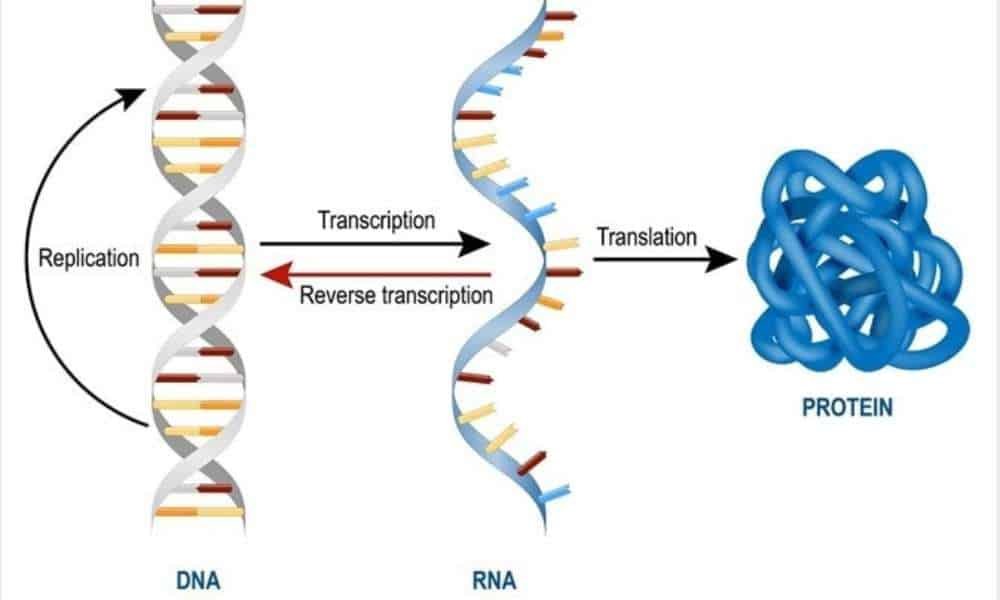
Structure of Ribonucleic acid
RNA molecules are made of ribonucleotides linked via phosphodiester bonds. Each nucleotide includes:
- Ribose sugar (a five-carbon sugar)
- Phosphate group
- Nitrogenous base: Adenine (A), Guanine (G), Cytosine (C), or Uracil (U)
The presence of the hydroxyl (-OH) group on the 2’ carbon of ribose makes RNA less stable than DNA, which is ideal for its temporary roles in gene expression and protein synthesis.
The RNA-specific pyrimidine uracil creates a complementary base pair with adenine and is utilized in place of thymine found in DNA. Although RNA is single-stranded, the majority of RNA molecules exhibit significant intramolecular base pairing, which forms a predictable three-dimensional structure necessary for their functions.
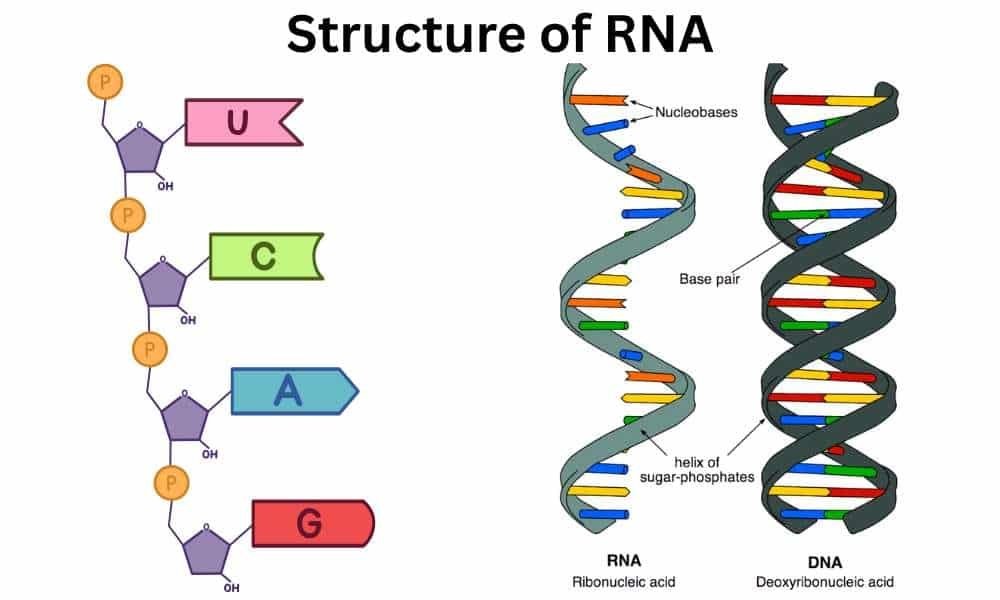
Major Types of Ribonucleic acid (RNA) and Their Functions
Protein production depends on three major forms of RNA. They include:
- Ribosomal RNA (rRNA)
- Transfer RNA (tRNA)
- Messenger RNA (mRNA)
1. Ribosomal RNA (rRNA)
Ribosomal RNA (rRNA) are the primary elements of ribosomes, which are in charge of protein synthesis by translating the instructions in messenger RNA into amino acid chains. The primary catalytic activity of ribosomes is provided by rRNAs. Additionally, rRNAs actively participate in identifying conserved features of mRNAs and tRNAs. The nucleolus produces rRNA molecules and contains the genes that code for them. Every ribosome contains at least one big rRNA and one small rRNA.
The high and low rRNAs interact with proteins to create ribosome subunits, such as prokaryotic particles 30S and 50S. These subunits are named based on their sedimentation rate. Eukaryotic cells can contain anywhere from 50 to 5,000 copies of rRNA molecules and up to 10 million ribosomes. In contrast, a prokaryotic cell often has less sets of rRNA molecules and ribosomes.
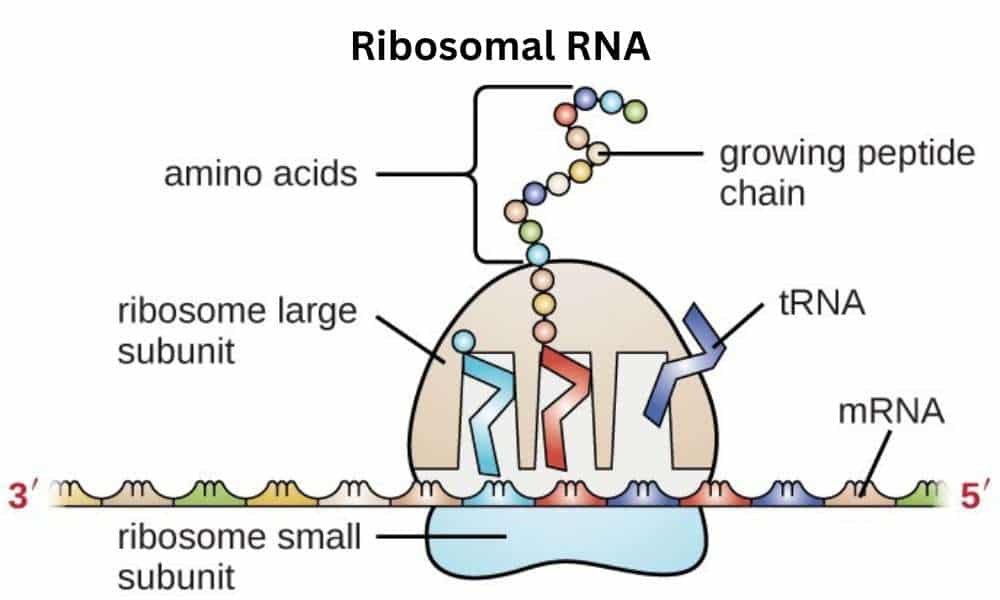
Types of rRNA
Prokaryotic and eukaryotic ribosomes are composed of various types of rRNA.
Prokaryotic rRNA:
- 30S subunit: Contains 16S rRNA
- 50S subunit: Contains 23S rRNA and 5S rRNA
- Together they form a 70S ribosome
Eukaryotic rRNA:
- 40S subunit: Contains 18S rRNA
- 60S subunit: Contains 5S, 5.8S, and 28S rRNAs
- Combined, they make up the 80S ribosome
Functions of rRNA
- The main role of rRNA is protein synthesis: The unique 3D architecture of rRNA generates the A, P, and E sites inside the ribosome, which includes internal helices and loops. These molecules guarantee that the codon sequence of the mRNA is correctly translated into the amino acid sequence of proteins by binding to messenger RNA and transfer RNA.
- The essential element of ribosomes, the cellular apparatus that translates messenger RNA (mRNA) into proteins, is rRNA. Ribosomes are made up of two subunits, each of which is made up of rRNA and proteins. The ribosome’s structural foundation is made up of rRNA molecules, which also aid in preserving its form.
- Ribozyme Function, or Catalytic Activity: rRNA acts as a ribozyme, which means it has the ability to catalyzes chemical processes. During protein synthesis, 23S rRNA in prokaryotic ribosomes and 28S rRNA in eukaryotic ribosomes catalyzes the creation of peptide bonds between amino acids. For the construction of polypeptide chains, this is crucial.
- mRNA Binding and Translation: rRNA aids in the binding of mRNA to the ribosome. It guarantees that the mRNA is correctly aligned with the ribosome for correct translation. Additionally, rRNA aids in the decoding of mRNA sequences into the appropriate amino acid sequences.
- Translation Regulation: By controlling the interactions between the ribosome and different translation factors, rRNA helps regulate translation, ensuring that the process is carried out effectively and precisely.
2. Transfer RNA (tRNA)
The little RNA molecule known as transfer RNA (abbreviated tRNA) is essential to the process of protein production.
Transfer RNA functions as a bridge (or adaptor) between the messenger RNA (mRNA) molecule and the lengthening string of amino acids that make up a protein. Each time an amino acid is added to the chain, a certain tRNA pairs with its matching sequence on the mRNA molecule, making sure that the proper amino acid is incorporated into the protein being produced.
Structure of Transfer RNA
- tRNA has a cloverleaf secondary structure and an L-shaped 3D form.
- The majority of transfer RNAs are short molecules, between 7090 nucleotides (5 nm) in length, that are encoded by several genes. The anticodon and the terminal 3′ hydroxyl group, which is capable of forming an ester bond with an amino acid, are the two most critical components of a tRNA molecule. But a tRNA’s structure also includes features like the D arm and T arm, which help make it extremely selective and efficient. Given the chemical similarity between many amino acids, it is astounding that just one in 10,000 amino acids is wrongly bonded to a tRNA.
- Similar to other nucleic acids in the cell, transfer RNAs have a sugar phosphate backbone, and the molecule’s directionality is determined by the orientation of the ribose sugar.
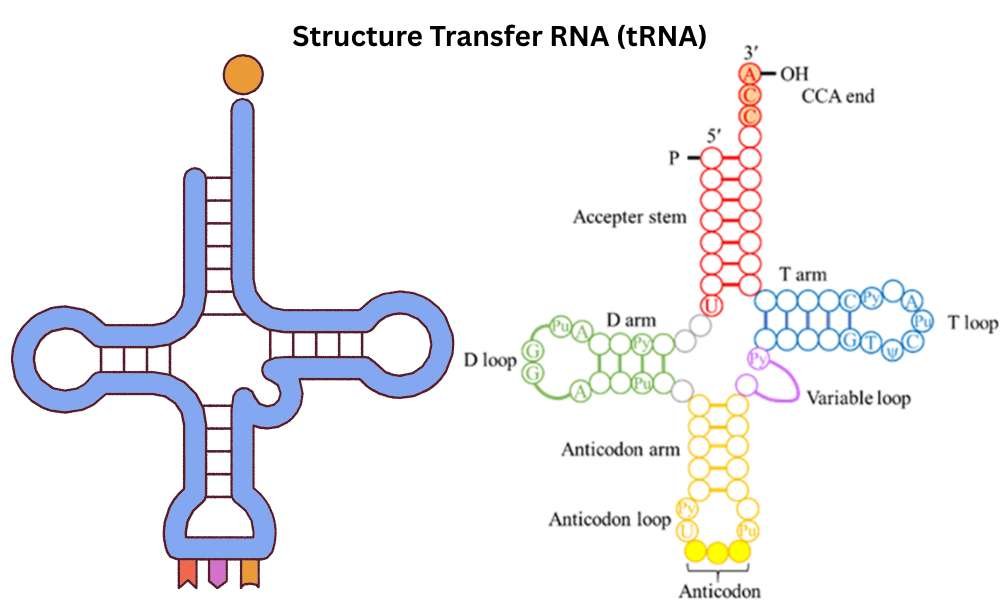
The main components of tRNA
- Acceptor Arm (3′ End): Ends with the sequence CCA at the 3′ end. Amino acid attachment site (where the desired amino acid attaches).
- Anticodon Loop: Contains a triplet of bases (anticodon) that complements the mRNA codon.
- Darm (D loop): Contains dihydrouridine base. Helps with proper folding and recognition by aminoacyl-tRNA synthetase.
- TψC arm (T loop): It contains ribothymidine (T), pseudouridine (ψ), and cytidine (C). Important for binding to the ribosome.
- Variable Loop: Varies in length. Provides structural flexibility.
Working of tRNA
- The anticodon region of tRNA contains complementary nucleotides that code for specific amino acids.
- For example AUG is the codon for methionine, and the tRNA anticodon has a complementary code, UAC. Once the amino acid has been coded, it is sent to the DHU site, which recognizes the methionine amino acid from the amino acid pool. This is accomplished with the help of the enzyme amino acyltRNA synthetase.
- After recognition, methionine is accepted at the carrier end of tRNA and transported to the ribosome recognition site, where it attaches to the ribosome.
Functions of tRNA
- It assists in protein synthesis.
- It assists in aminoacylation, the first step in protein synthesis.
- It transports the necessary amino acid from the amino acid pool to the mRNA, where it combines to form a polypeptide that produces proteins.
- It assists amino acids in binding to mRNA to generate proteins.
- It aids in the identification of specific amino acids and transports them to the ribosomal unit for translation.
- The ribosome site where the polypeptide chain elongates has three binding sites for tRN Aaminoacyl (A site), peptidyl (P site), and exit (E site).
- It contains an anticodon that decodes the amino acid code for a specific amino acid found in mRNA.
3. Messenger RNA (mRNA)
The process of transcription uses a DNA template to produce messenger RNA (mRNA), which is a sort of single-stranded RNA that participates in protein synthesis. mRNA’s function is to transfer protein information from the DNA in a cell’s nucleus to the cytoplasm (watery interior) of the cell, where the protein-producing machinery reads the mRNA sequence and converts each three-base codon into its matching amino acid in a developing protein chain.
Structure of mRNA
Generally speaking, mRNA in biological creatures is made up of a number of components, such as the 5′ end, the coding area, the 3′ untranslated region, and the polyadenylate tail, also known as the PolyA tail.
The mRNA in prokaryotes (organisms without a distinct nucleus) is made up of a transcribed copy of the DNA sequence, complete with a terminal 5′ triphosphate group and a 3′hydroxyl residue.
In eukaryotes (organisms with a clearly defined nucleus), the structure of mRNA molecules is more complex. A cap structure is created when the 5′ triphosphate residue is further esterified. A poly (A) tail made up of many adenosine monophosphates is usually found at the 3′ end and is added enzymatically following transcription.
From an original precursor mRNA, eukaryotic mRNA molecules, often made up of introns and exons, go through a process of cleavage and re-joining. Due to the absence of the cap structure and poly (A) tail, prokaryotic mRNAs are typically degraded considerably faster and are less stable than eukaryotic mRNAs.
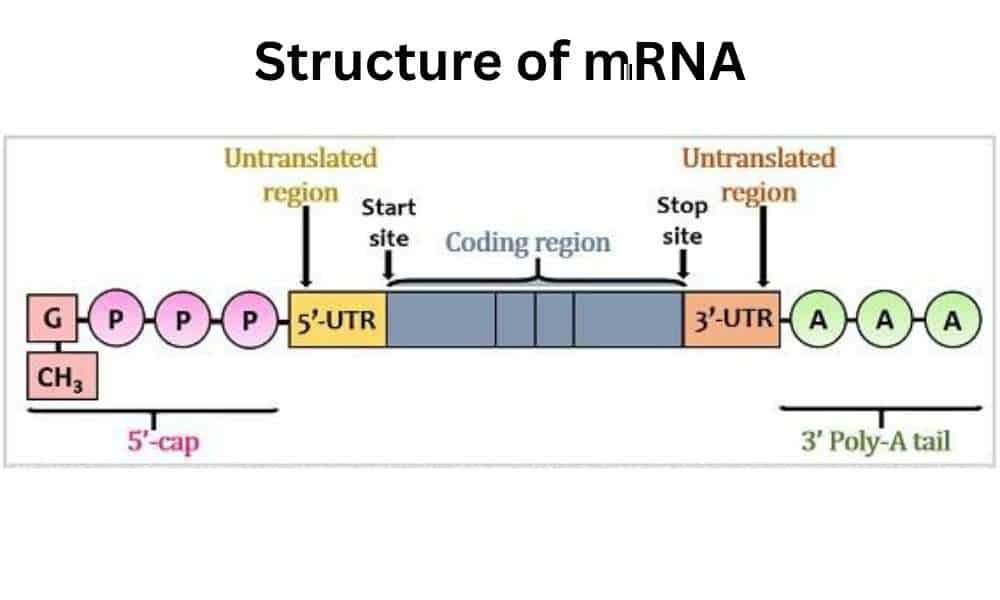
Types of mRNA
Prior mRNA: As a mature mRNA exits the DNA template, it serves as its primary transcript. Before translation, sequences in the pre-mRNA are deleted. Spliceosomes, which are complexes of protein and RNA molecules, remove these sequences. Some adjustments are made to the 5′ and 3′ termini, respectively, in addition to the deletion of sequences. Now we refer to it as mature mRNA since it is prepared for translation after the undesirable sequences have been eliminated and the 5′ and 3′ ends have been changed.
Monocistronic mRNA: Exon areas of this kind of mRNA molecule encode just one protein. Since every eukaryotic mRNA is Monocistronic, they all undergo posttranslational modification to start protein production. It is transcribed from a single gene (cistron) and has one start and stop codon.
mRNA with several codons: This mRNA molecule codes for several proteins, unlike monocistronic mRNA. found both in the chloroplast of plants and in prokaryotic cells. It is transcribed from more than one gene, resulting in several start and stop codons.
Functions of mRNA
- Serves as the template for protein synthesis
- Transmits genetic information from nucleus to cytoplasm
- Interacts with ribosomes and tRNA during translation
- Involved in gene regulation and cell signaling
- Subject to regulation by miRNAs, RNA-binding proteins, and modifications
Conclusion
RNA plays an indispensable role in the flow of genetic information, as outlined in the central dogma of molecular biology (DNA → RNA → Protein). Understanding the structure and types of RNA is critical to molecular biology, virology, and biotechnology — and essential for microbiologists and medical professionals.

